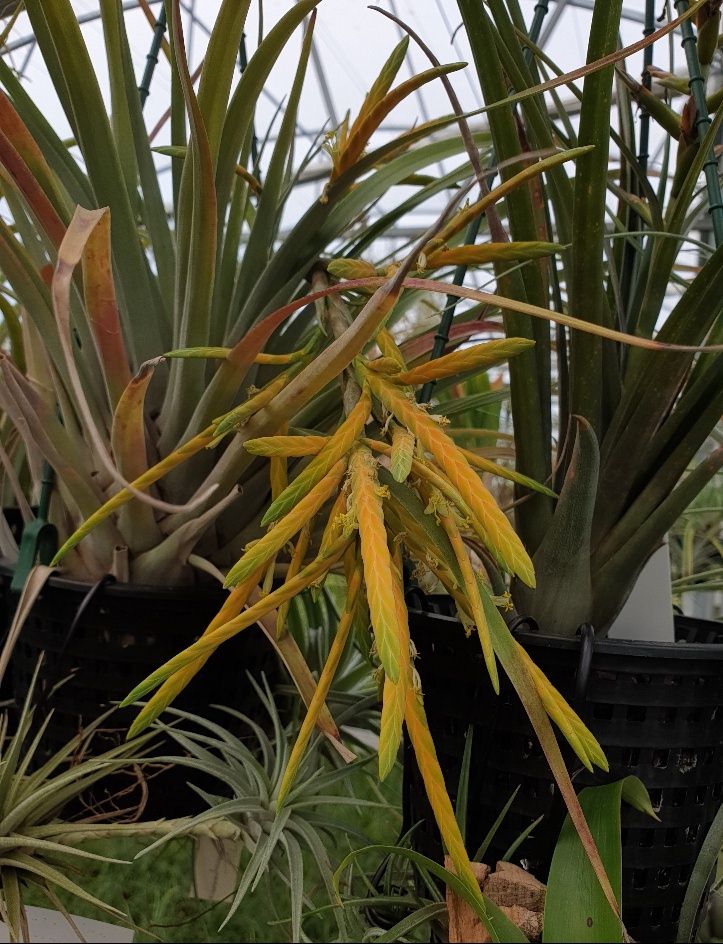
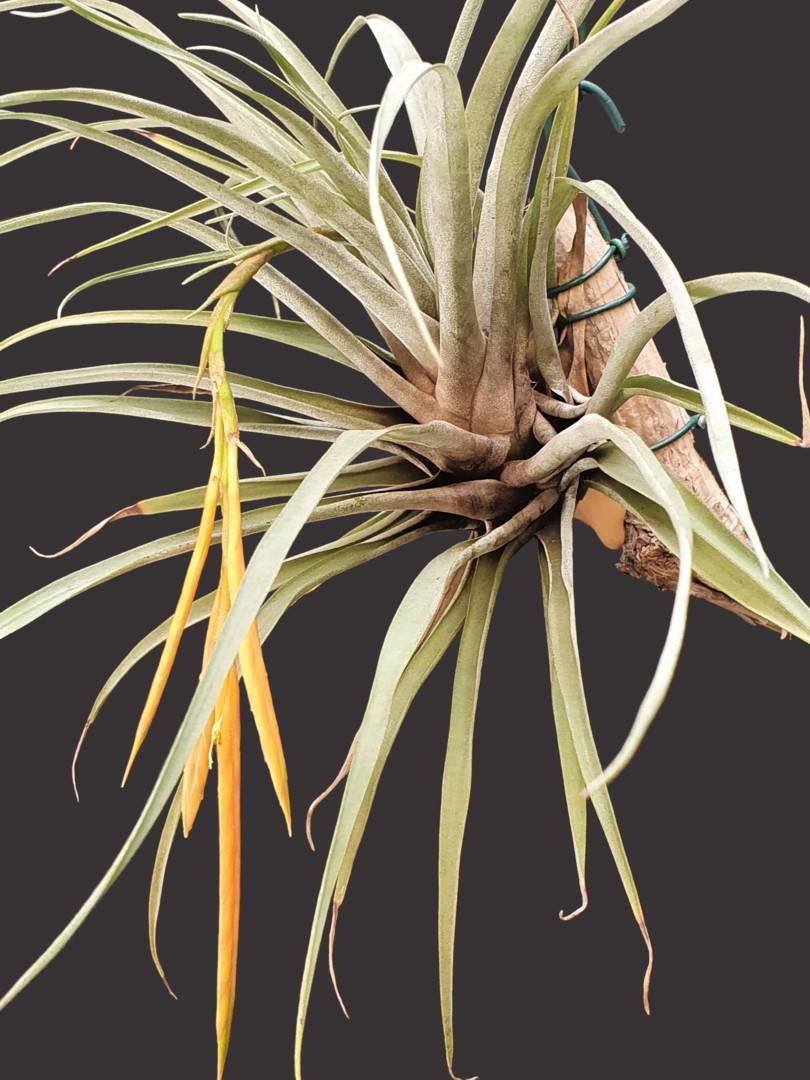
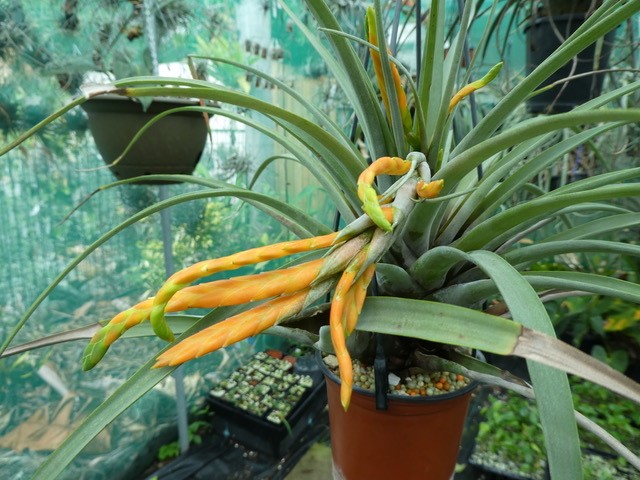
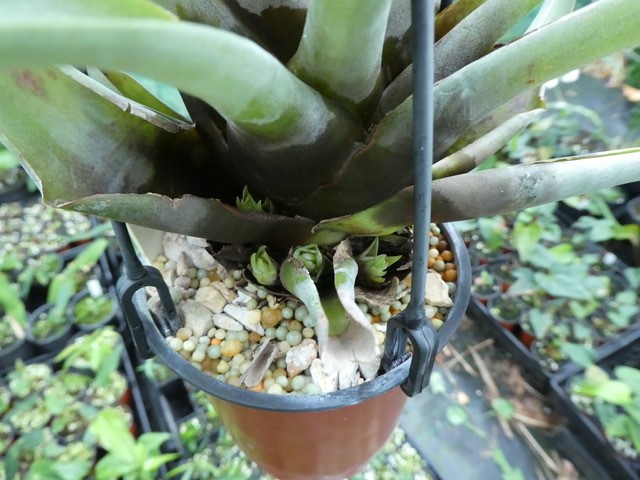
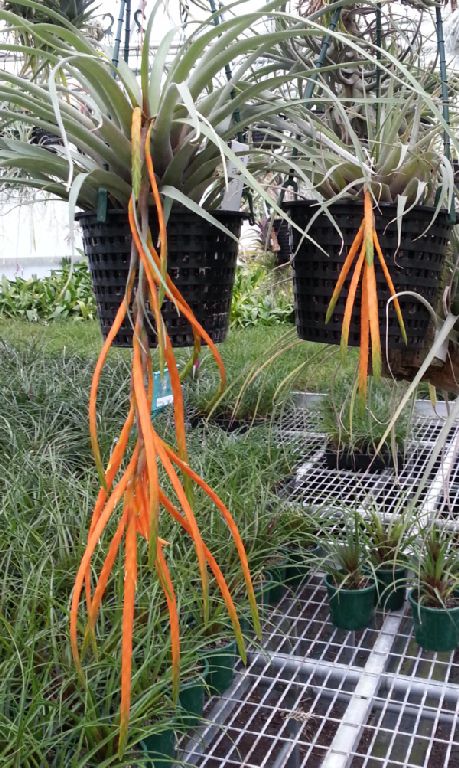

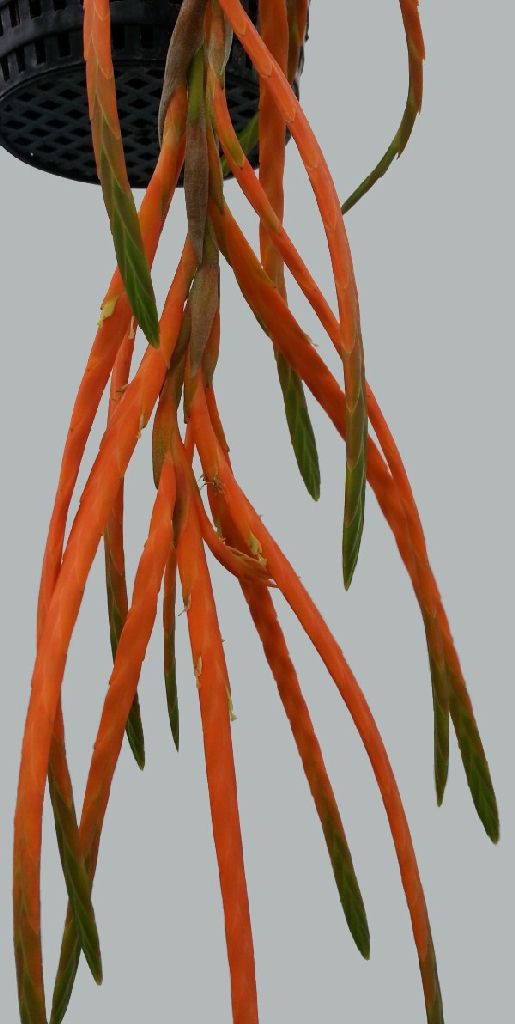

Chris Larson ... "I’ve been flowering these plants over the past few weeks and have noted that these have a different coloured bracts to the ones both Peter & I have flowered previously.
Of the ones we flowered previously – all were yellow spikes as shown under the photos of T. barthlottii on the newest disc by Peter – and of course subject to an earlier post so most of you have seen the plants before.
There are also photos of mine on Bromeliads of Australia under T. rusbyii (note how small the pot is).
Those getting T. rusbyi from me in the past – they may be T. barthlottii with the yellow spike. Check Rauh’s comments below – or just get one of the invaluable DVDs.
This year I am flowering some plants from the same source, but a different lot. This time they are flowering with a distinctly orange inflorescence.
Whatever (as my kids say) - but these are stunning species.
Cheers, Chris."
Rauh ... "Vegetatively T. rusbyi can be compaired favourably with T. barthlottii. Resembling this, it forms a stemless, bulbose at the base, to 25 cm high rosette. Forming a virtual sphere, about 4 x 4 cm in size, a distinct sheath with dark brown scales with a narrow lanceolate, involute blade ca. 1 cm wide, tapering to a long, filiform tip, densely gray lepidote. The visible differences only appear at flowering. T. rusbyi does not have a digitate inflorescence with laxly hanging spikes but clearly pinnate, with to 5 cm long lepidote axis and in almost distichous order up to 12, spreading horizontally spikes ( fig. l0a). These have a 1-1.5 cm long stem and reach only to 6 cm long (with T. barthlottii to 40 cm), and 0.5 cm wide. The floral bracts in contrast to those of T. barthlottii are densely imbricate, ecarinate, densely lepidote, only 0.5 cm long and shorter than the sepals. With T. barthlottii however these are 1.2-1.5 cm long, much longer than the sepals and totally glabrous.
The Bolivian T. rusbyii Bak, in which L. B. Smith (in: Rhodora, Vol. 71, 1969, p. 244) also includes as synonyms T. buchtienii Winkl. (in: Fedde's Rep. Spec. Nov 7, 1909, p. 107) and T. guentheri Harms, (in: Notizblatt, Botan. Garten Berlin10, 1929, p. 794), is distinguished from the Peruvian species by having about 14, distichously arranged spikes that are half erect to spreading, 9-16 cm long, to 20-flowered; the 11-12 mm long, lepidote floral bracts are laxly imbricate and a little exceed the sepals; the Stamens enclosed. But T.barthlottii differs from the Bolivian plant by the finger forming branched, hanging inflorescence."
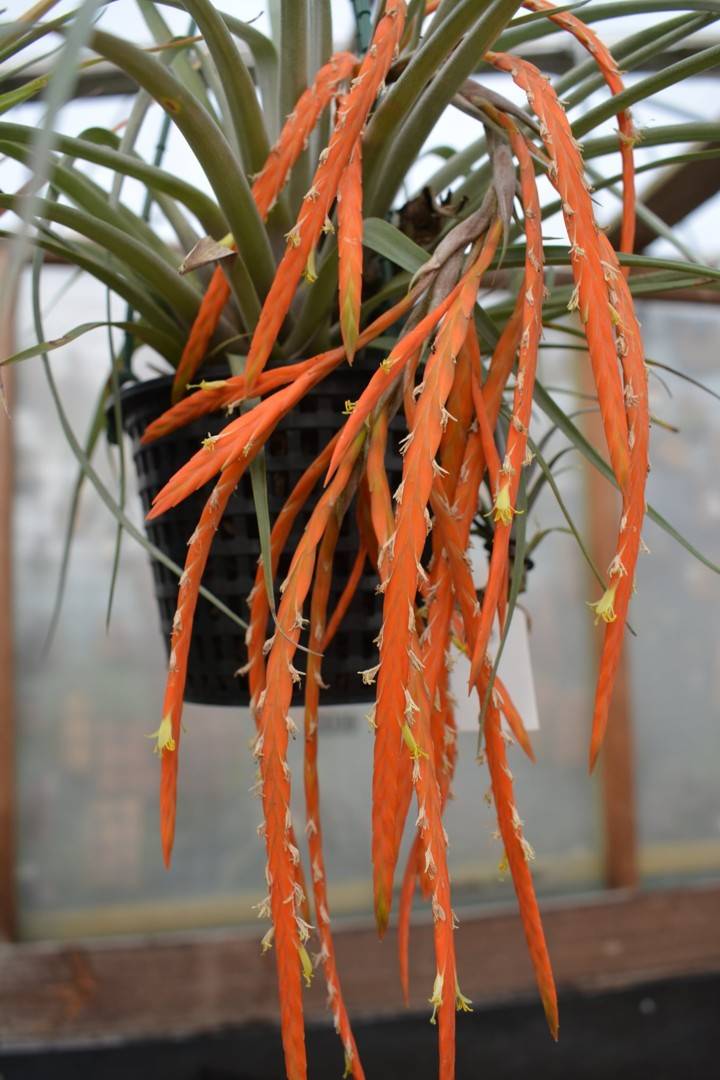
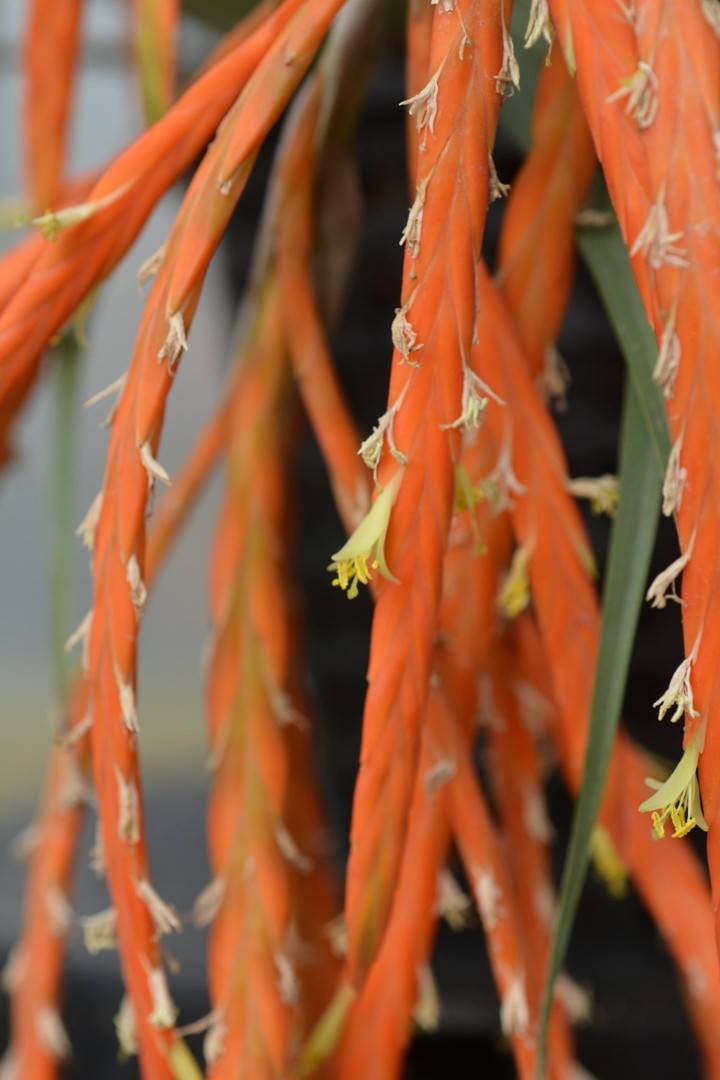

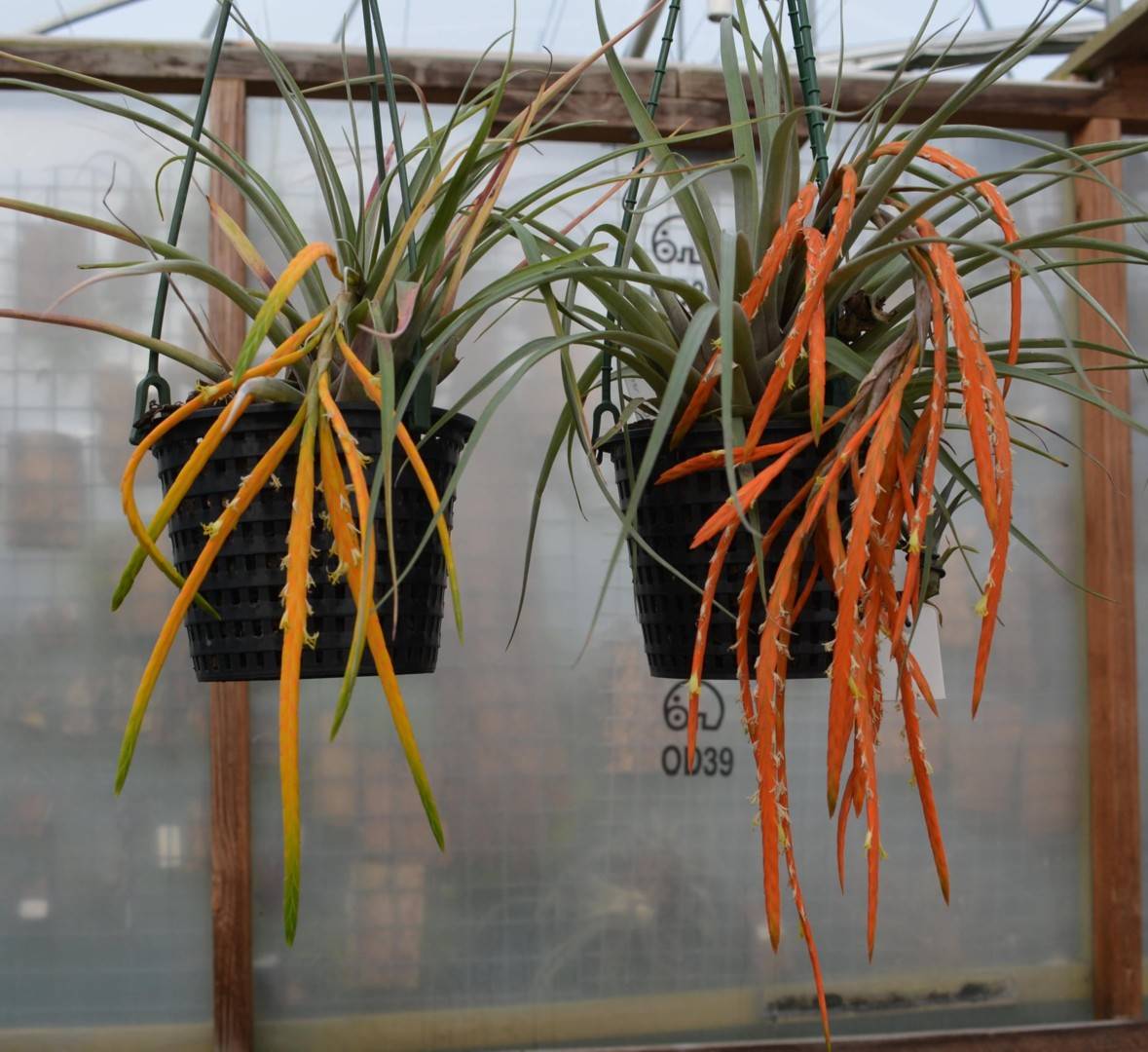
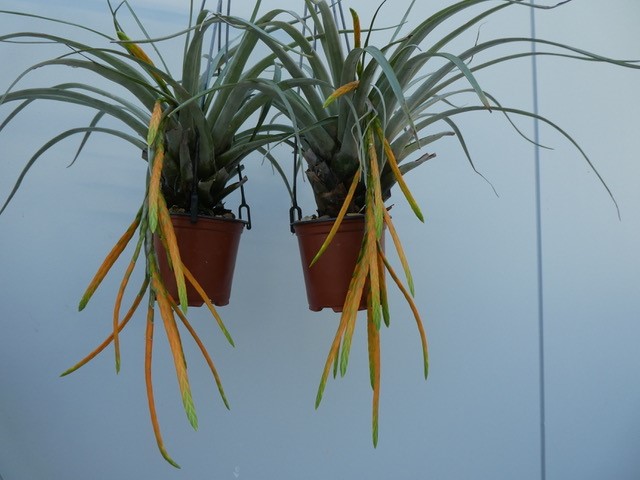
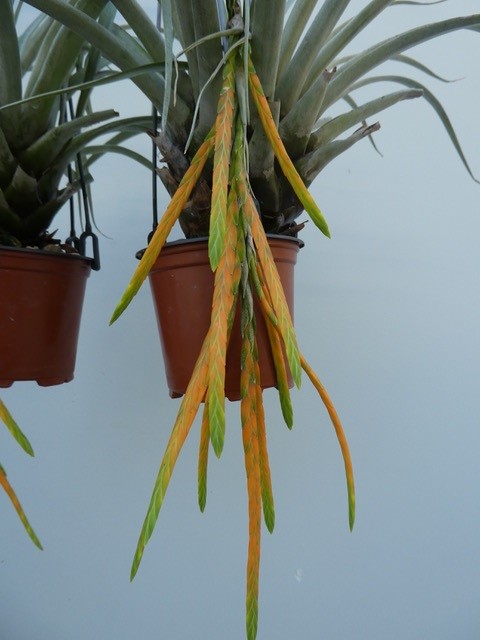

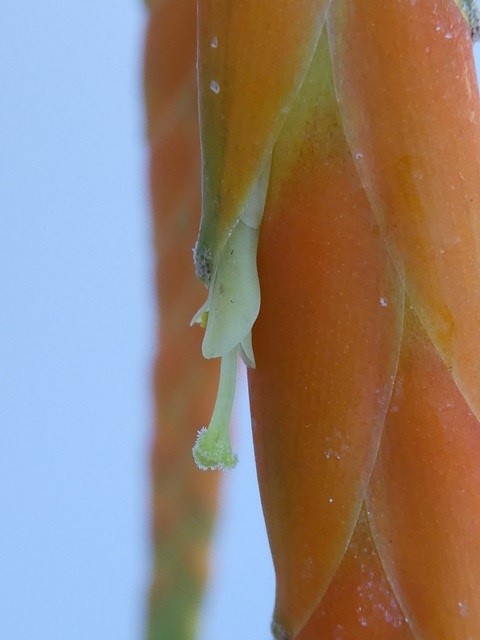


Plant stemless, inflorescence hanging, Leaves numerous, forming a rosette 40cm high with a moderately bulbose base, 10cm diam.
Leaf sheath roundish oval, 4–7cm long, 4–6cm wide, both sides dense appressed dark brown lepidote, distinct from blade.
Leaf blade to 30cm. long, narrow triangular attenuate, 2 cm. wide next to sheath, rolled inwards, underneath dense grey appressed lepidote, above laxly lepidote.
Scape 5–15cm long, shorter than the rosette, erect, the top bowed downwards, curved, 3–4mm diam., green, terete, blabrous.
Scape bracts dense grey lepidote, densely imbricate, covering the whole stem, the bottom ones leaflike, blades 10–40cm long, filiform, rolled inwards, the upper ones longer sheath and filiform blades 1cm long.
Inflorescence limply pendulous, up to 40cm long, bipinnate, with ca. 7 digitate spikes.
Primary bracts similar to the upper scape bracts, lanceolate-oval, aculeate, grey-green, lepidote, much shorter than the spike but longer than the green bottom portion of the spike to 1.5cm long, sterile and leafless.
Spikes with a stalk, to 10–30 (-40) cm long, 0.5cm wide, fan shaped, the bottom sterile bracts a few scattered lepidote, the axis wide and flat, glabrous, green, with many (to 25) flowers.
Floral bracts densely imbricate, not keeled, 12–14mm long, to 7mm wide, exceeds the sepals, naked, the top half a splendid orange, the bottom green, when fresh smooth, when dry distinctly nerved.
Flowers erect, to 15mm long, inconspicuously zygomorphic.
Sepals keeled, free, 8–10mm long, 2mm wide, naked, pale yellow to greenish, tips blunt.
Petals (white in Latin – cream in German!) to pale green, narrow tongue-like, to 15mm long, 3mm wide, tip blunt spreading.
Stamens & Style after anthesis exceed the flower.
Type Rauh 34911 (HEID) Isotype (US)
Habitat In Sucua valley (Prov. Morana Santiago) Epiphytic, about 800m, and in the Zamora valley about 1200 –1500m.
Differs from T. flagellata by having
1. Spike much longer and more narrow
2. Flower bracts much shorter
3. Sepals much shorter.
Other collections
Rauh 35231 & 35233, Ecuador, Zamora valley (Prov. Loja) between Loja and Zamora (Atlantic side of the Andes) between 1300- 1500m
Rauh 53 714, Peru, between Rioja & Pomacochas (Dept. San Martin) near km325, below cliffs
T. barthlottii has another habitat in the southern, Atlantic Ecuador, on the basis of our observations. It was first found by us near km 184 near Sucua, close to the road Cuenca-Macas (Prov). Morona Santiago, epiphytic on Crescentia trees. Later they could be found also further south in the valley of Zamora (Prov. Loja) between Loja and Zamora (on the Atlantic side of the Andes) in high ground between 1300 m and 1500 m collections (Nr. 35231 and 35233; fig. 11).
With its hanging inflorescence, with very narrow spikes and intensively two-colored floral bracts (orange-yellow green), T. barthlottii has a very striking appearance, that is assigned to the Subgenus Tillandsia L. B. Smith (= Platystachys Beer). Its habit is much like the plants known as “grey” Vriesea. As such when we first saw them, we checked that the petals had no ligules.
The nearest relative to T. barthlottii seems to be T. flagellata L. B. Smith. However, from the original diagnosis (Phytologia, Vol. FI, p., 358, 1958), and herbarium material it is not known if this has a similar hanging inflorescence. The scape according to Smith is “erect to suberect, the inflorescence subdigitate from about 7 spikes, these divergent to spreading" (p. 259). T. flagellata has spikes only 4-7 cm long, to 1 cm wide, “densely few-flowered, the floral bracts 24 mm long, strongly nerved, lepidote, the sepals 16 mm long" (L. B. Smith, l.c.; Fig. 10). T. barthlottii, of which we have seen numerous examples flowering, are even more narrow, only to 5 mm wide spikes at least 30 cm, in extreme cases to 40 (!) cm long and many flowered, floral bracts smooth, (only nerved when dry), shiny, glabrous and the sepals only 8-10 mm long.
Comparison between that in fig. 7-8 examples of T. barthlottii with that portayed in fig. 10 of the type plant for T. flagellata L. B. Smith shows unequivocally that both species are not that identical.
Also in the geographical area sense both species differ. T. flagellata collected by Hitchcock (No. 21245), only once near the gold mine near Zaruma, Portovelo, Prov. El Oro, between 800-1000 m, (fig. 10) in fact without flowers, so that Smith himself was in the doubt as to whether classify T. flagellata as a Vriesea. “ln the absence of complete flowers I am the arbitrarily assigning this novelty to Tillandsia since species of this general habitat are about evenly divided between Tillandsia and Vriesea", (Smith, l. c).
T. barthlottii shows a conspicuous similarity also to the Andea species dispersed through Peru and Bolivia, namely to T. rusbyi Bak. (1889). From Mez (1905), this was treated as a synonym of T. lorentziana Griseb. (1874), but rightly contradicted in 1969 by L. B. Smith, (Rhodora, 71, p. 244). He recognized T. rusbyi Bak. again as a species which had been discovered by Ule in the Amazonas area of North-Peru however with the described T. glumaciflora Ule, (collection Nr. Ule 54 p, 1903, Cerro de Escalera, 1300 m, Dptm. Loreto; diagnosis in: Verh. bot. Ver. Brandenburg, volume, XLVIII, 1907, p. 143), that in 1905 Mez had already placed under the name T. ulei Mez (Bull. Herb. Boiss. II, 5, 1905, p. 102). In fig.10a shows the original plant collected by Ule (T. glumaciflora Ule, Collection Nr. 54p).
Vegetatively T. rusbyi can be compaired favourably with T. barthlottii. Resembling this, it forms a stemless, bulbose at the base, to 25 cm high rosette. Forming a virtual sphere, about 4 x 4 cm in size, a distinct sheath with dark brown scales with a narrow lanceolate, involute blade ca. 1 cm wide, tapering to a long, filiform tip, densely gray lepidot. The visible differences only appear at flowering. T. rusbyi does not have a digitate inflorescence with laxly hanging spikes but clearly pinnate, with to 5 cm long lepidote axis and in almost distichous order up to 12, spreading horizontally spikes (fig. l0a). These have a 1-1.5 cm long stem and reach only to 6 cm long (with T. barthlottii to 40 cm), and 0.5 cm wide. The floral bracts in contrast to those of T. barthlottii are densely imbricate, ecarinate, densely lepidote, only 0.5 cm long and shorter than the sepals. With T. barthlottii however these are 1.2-1.5 cm long, much longer than the sepals and totally glabrous.
The Bolivian T. rusbyi Bak, in which L. B. Smith (in: Rhodora, Vol. 71, 1969, p. 244) also includes as synonyms T. buchtienii Winkl. (in: Fedde's Rep. Spec. Nov 7, 1909, p. 107) and T.guentheri Harms, (in: Notizblatt, Botan. Garten Berlin10, 1929, p. 794), is distinguished from the Peruvian species by having about 14, distichously arranged spikes that are half erect to spreading, 9-16 cm long, to 20-flowered; the 11-12 mm long, lepidote floral bracts are laxly imbricate and a little exceed the sepals; the Stamens enclosed. But T. barthlottii differs from the Bolivian plant by the finger forming branched, hanging inflorescence.